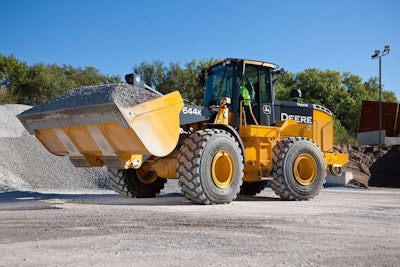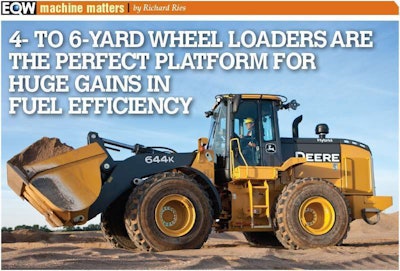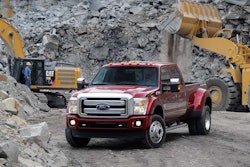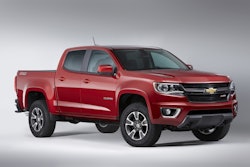
 The 644K hybrid wheel loader from Deere captures regenerated energy as it is being created and uses it to power the machine. The hybrid loader is equipped with a John Deere PowerTech 6.8-liter Tier 4 Interim engine, which delivers hydraulic responsiveness and reduced cycle times. Other features include noise reduction, PowerShift transmission, four operating speed ranges, a Sealed Switch Model and a brushless generator.
The 644K hybrid wheel loader from Deere captures regenerated energy as it is being created and uses it to power the machine. The hybrid loader is equipped with a John Deere PowerTech 6.8-liter Tier 4 Interim engine, which delivers hydraulic responsiveness and reduced cycle times. Other features include noise reduction, PowerShift transmission, four operating speed ranges, a Sealed Switch Model and a brushless generator.
For most machines, Tier 4 Final fuel efficiency gains are around 5 percent. Yet fuel efficiency for wheel loaders is up 20 percent and more. How is that possible?
There’s not some magical technology applied to wheel loaders that’s yet to be rolled out to other machines. In fact, every technological advance on wheel loaders can be found on other machines.
What made wheel loaders especially suitable for huge gains in fuel efficiency was their use patterns. “Wheel loaders use their wheels as much as their hydraulics,” says Stefan Salomonsson, product manager, wheel loaders, Volvo Construction Equipment. “This makes their use patterns unique. Other machines don’t have as much opportunity for improvement in fuel usage.”
Mike Stark of Doosan emphasizes that the enabling technologies are the same on wheel loaders as on other machines: programmable engine control units (ECUs), transmission and hydraulic system design improvements and the use of a single overarching electronic “hub” to oversee operations (Doosan calls theirs a “Vehicle Control Unit,” or VCU). “Wheel loaders were especially ripe for improvement because of they have lots of travel, lots of charging the pile and lots of lift, travel and dump. Most other equipment is biased toward a single operation.”
Among the many technologies used in wheel loaders and other equipment, two stand out.
Smarter hydraulics
Any new wheel loader can be used to illustrate the role of modern hydraulics; we’ll use Komatsu’s WA270-7. Its hydrostatic transmission has a single pump driving two motors that transfer power to the wheels via a mechanical system. Traction control is part of the system. On the WA270-7, the traction control includes a setting giving the machine’s computer full control of traction to optimize performance and maximize fuel efficiency.
The hydraulic system on the WA270-7 uses a variable displacement piston pump. A variable displacement pump alters flow internally; flow doesn’t rely on engine speed. The engine can run slower, enhancing fuel efficiency with no loss of hydraulic performance. The pump on the WA270-7 has a closed-center, load-sensing design to enable quick and continuous response of the hydraulic system to changes in load.
Hydraulics also control the variable geometry turbocharger (VGT) and the variable speed, auto-reversing cooling fan.
Smarter electronics
Controller area network bus (CAN bus) systems have been around for a while, but the number of electronic systems has grown past what a CAN bus can handle well. Beyond engine, transmission, and hydraulics, today’s wheel loaders also have multiple user-selectable performance settings, telematics to gather and relay information in real time, and multiple sensors to monitor such things as wheel slip. Higher-level electronics are required to manage all these features.
Liebherr’s answer is Master 4. With 64-bit architecture and large memory, Master 4 has the speed and capacity required to manage a wheel loader’s full complement of electronics, including the CAN bus and the Liebherr Power Efficiency system that optimizes the performance of the drive train. “The Master 4 is the main computer system responsible for integrating all machine components in a single system,” says Ana Cabiedes-Uranga, marketing and communications manager.
Kawasaki’s IntelliTech system manages several subsystems. IntelliDig balances rimpull and hydraulic digging force. SimulLoad coordinates lift and tilt while digging. QuickCycle speeds V-loading cycles. IntelliTech also improves transmission performance. Shift points can be altered to match working conditions. A downshift switch enables faster downshifts while a shift hold button maintains the present gear. AutoMode offers automatic operation in gears 1 through 5 or 2 through 5 as well as a manual mode. Declutching is seamless on level or sloping ground.
Impact on O&O costs
Changes in wheel loader design and operation will have an effect on owning and operating costs. How much? “The impact on a customer’s O&O cost will vary depending on whether the customer is upgrading from older equipment (Tier 3 or before) or newer equipment (Tier 4 Interim),” says Lucas Sardenberg, wheel loader marketing consultant for Caterpillar. “If you look back to Tier 3 units and before, emissions compliance came at the cost of fuel efficiency. A customer upgrading from a Tier 3 machine to a Tier 4 Final will see up to 25 percent better fuel efficiency, partially offset by additional cost for DPF servicing and DEF consumption. A customer migrating from a Tier 4 Interim model to Tier 4 Final will see better fuel efficiency that in most cases more than offsets the additional price for DEF. A good tip for all customers is to make extensive use of telematics to track costs.”
Some changes to O&O costs are subtle. “For example,” says Cabiedes-Uranga, “there is almost no brake wear due to the self-braking action of the hydrostatic drive. At the same time, there is also 20 percent less tire wear since the continuous traction control of the drive line minimizes wheel spin.”
John Chesterman, product marketing manager for production-class wheel loaders with John Deere, says auto-idle shutdown will also affect costs. “Customers need to understand that hourly fuel consumption goes up because if the loader is running, it’s working. But overall consumption goes down because you’ve eliminated fuel wasted during unnecessary idling.”
Residual value is also affected. “A big part of the residual value equation is the ability to export machines,” says Salomonsson. “This continues to have high variability due to the availability of ultra low sulfur diesel fuel in other countries.” Some equipment can be “de-tiered” and made to run on non-ULSD fuel. Some countries are moving to ULSD. Some machines are simply incompatible with a large part of the export market. These factors greatly influence the resale value of equipment.
Stark says Tier 3 machines got a bump in residual value because “some customers don’t want to mess with DEF or were put off by the higher initial cost of Tier 4 models.” He says given the many advantages of Tier 4 equipment, including fuel efficiency, those machines should hold their value well.
Changes for operators, service techs
Pete Gallagher, wheel loader product sales manager in North America for JCB, says educating operators on operational techniques is essential. The lock-up torque converter, for example, should be used on travel runs of 165 feet or more but has no benefit during V-pattern loading. Operators can toggle the lock-up feature on or off accordingly. DPF is another area requiring education as operator habits can have a big impact on DPF function.
Gallagher also says that while the advanced design of today’s wheel loaders puts less emphasis on operator skill, “in every application you can see the difference between a well-trained, highly-skilled operator and one with less training and lesser skills. The magnitude of that difference depends largely on the application. Site prep magnifies the difference while stockpiling minimizes it. But the difference is always apparent even with the most sophisticated equipment.”
Although not directly connected to fuel savings, there are changes in Tier 4 machines that will affect both operators and service technicians. Todd Johnson, district sales manager for Hyundai, uses regeneration as an example. While passive regen is transparent to the operator, active regen requires that operators find a 15-minute window for the process to occur. “Operators understand that hotter is better,” says Johnson, “and that operating habits can extend active regeneration intervals out to 2,000 hours or even longer.” He says machines should be run hard then allowed to cool down for three minutes (“one song on the radio”) before shutdown. Minimizing idling also helps extend regen intervals.
Johnson points out the importance of competency in service. For example, swapping out an injector must be done with care and the details recorded. “One injector can take you out of emissions compliance.” Outsourcing service doesn’t make you immune from problems. As with site contamination where the EPA uses the “strict, joint, and several” approach to penalties, equipment owners are responsible for keeping their machines in emissions compliance whether they do the work in-house or sub it out.
Service personnel need to be aware of general shifts in the industry, says Philippe Bisson, brand marketing manager for Case Construction Equipment. He cites coolant as an example. “Many Tier 4 machines are switching to Organic Acid Technology (OAT) coolant for increased protection and overall better coolant performance. OAT coolants help eliminate fouling and deposits that prevent heat transfer from the metal to the coolant. But OAT coolants are incompatible with other coolants and service personnel need to be aware of what coolant is shipped in each machine.”
Sardenberg makes a similar point regarding DEF. “Caterpillar recommends topping off the DEF tank every time the machine is refueled. DEF should be stored in a stable, protected environment as exposure to sun and temperature variations can degrade its quality.” (For more on proper DEF handling, check out equipmentworld.com.)
Technology flow in and out
Hybrids are emerging in the equipment market, but they’re more like rail locomotives and mine trucks than passenger vehicles. Deere’s two hybrid loaders, the 644K and 944K, illustrate this. An engine drives a generator which then powers the machine’s electric drive system. The result is excellent torque at low engine speed, high rimpull with a comparatively small engine, and fuel savings. The 6.8-liter engine in the 644K runs at a constant speed – 900; 1,200; 1,500; or 1,800 rpm – to match the load. Some customers report cutting fuel consumption nearly in half when running at 1,500 rpm.
Why now? What now?
So if wheel loaders have been so ripe for huge gains in fuel economy, why have manufacturers waited this long to deliver? Part of the answer is that it took this long for the required technologies to mature and make it into production. Part of it is that manufacturers held back a bit so they could offer improved fuel usage along with a host of other features to help offset the higher cost of Tier 4 machines. “Tier 4 put a date on the calendar,” says Bisson. “This is years of research and development plus technologies brought in from other industries (SCR has been proven in on-road trucking for many years), all coming together in this generation of equipment.”
So is there another giant leap just over the horizon? Should customers take the plunge now or wait for the next big thing? Gallagher says there’s no time like the present. “Today’s wheel loaders offer outstanding production in terms of material moved per unit of fuel. Do you want to give up three years of productivity while awaiting something better? The industry is constantly advancing and will continue to develop new and better machines. But today’s equipment offers the best performance ever and waiting means missing out on that.”












